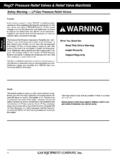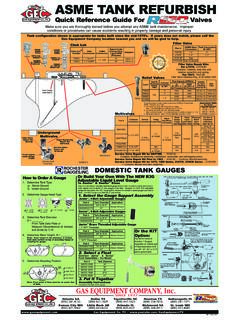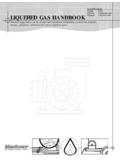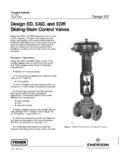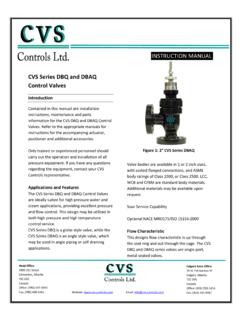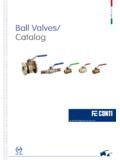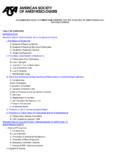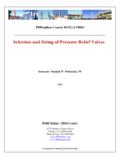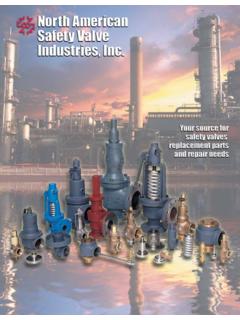Transcription of LP-Gas Emergency Shut-Off Valves (ESV’s)
1 112 Emergency Shutdown ValvesRegO Emergency Shutdown Valves (ESVs)Why and how they should be used for Bobtail Filling and Transport InformationThe primary purpose of Emergency Shut-Off Valves in bobtail fillingand transport unloading is to allow quick Shut-Off of liquid and vaporflow in the event there is an accidental pull-away of a truck or a hoserupture, both of which could cause a system using Emergency Shut-Off Valves will not prevent somespillage of liquid and vapor, but the total system should be constructedso this spillage will be kept to a Emergency shutoff Valves shall be approved andincorporate all the following means of closing:(a) Automatic shutoff through thermal (fire) actuation.
2 When fusibleelements are used they shall have a melting point not exceeding 250 F. (121 C).(b) Manual shutoff from a remote location.(c) Manual shutoff at the installed provision sets for the basic criteria for the Emergency shutoffvalve, a key valve in the protection of many liquid transfer means for remote control may be electrical, mechanical systems use a pneumatic system where the tubing itself acts asa fusible element releasing the pressure holding the valve open. Withrespect to the feature of manual shutoff at the installed location, it isrecommended that this valve be operated occasionally. Also, the sys-tem should be tested periodically to determine that it will on new installations, and by December 31, 1980 onexisting installations, (1) stationary single container systems of over4,000 gal.
3 ( m3) water capacity, or (2) stationary multiple con-tainer systems with an aggregate water capacity of more than 4,000gal. ( m3) utilizing a common or manifolded liquid transfer line,shall comply with (a) and (b).(a) When a hose or swivel type piping 1 or larger is used for liquidtransfer or a 1 or larger vapor hose or swivel type piping is used inthis service (excluding flexible connectors in such liquid and vaporpiping), and Emergency shutoff valve complying with shall beinstalled in the fixed piping of the transfer system within 20 ft (6m) oflineal pipe from the nearest end of the hose or swivel type piping towhich the hose or swivel type piping is connected. The precedingsizes are nominal.
4 Where the flow is only in one direction, a backflowcheck valve may be used in lieu of an Emergency shutoff valve ifinstalled in the fixed piping down-stream of the hose or swivel typepiping, provided the backflow check valve has a metal-to-metal seat ora primary resilient seat with a secondary metal seat not hinged withcombustible material. When either a liquid or vapor line has two ormore hoses or swivel type piping of the sizes designated, either anemergency shutoff valve or a backflow check valve shall be installedin each leg of the piping.(1) Emergency shutoff Valves shall be installed so that the tempera-ture sensitive element in the valve, or a supplemental temperaturesensitive element [250 F.]
5 (121 C) maximum] connected to actuatethe valve, is not more than 5 ft. ( m) from the nearest end of thehose or swivel type piping connected to the line in which the valve isinstalled.(b) The Emergency shutoff valve(s) or backflow check valve(s) speci-fied in (a) shall be installed in the plant piping so that anybreak resulting from a pull will occur on the hose or swivel type pipingside of the connection while retaining intact the Valves and piping onthe plant side of the connection. This may be accomplished by use ofconcrete bulkheads or equivalent anchorage or by the use of a weak-ness or shear fitting. Such anchorage is not required for tank can be accomplished either by making possible, quick action bythe driver or plant personnel in closing the Valves by manual remote orpneumatic remote actuation; or in case of a pull-away, by automaticclosing of the liquid valve by means of a cable connected to the minimizing the presence of liquid and vapor, the chance of a fire orexplosion will be reduced.
6 In case of a fire, thermal links at the valvesor at other appropriate locations could close the Valves and preventfurther release of liquid and valve closing systems will be discussed later in this section. Theuser should decide which system is most appropriate, depending onthe piping configuration and the general layout of the Application for Bobtail Loading and Transport UnloadingA very important function of the typical LP-Gas storage plant is totransfer LP-Gas into bobtails for delivery to customers. How efficient-ly and rapidly these bobtails can be filled often determines the numberof customers that can be served each day, as well as how many bob-tails are required to satisfactorily serve all customers.
7 Therefore, theselection of an ESV for the bobtail liquid loading line should be donewith care so as to maximize efficiency in filling and have RegO 2 liquid ESV (6016) has a full open port so that therestrictions of flow would be no more than you would expect throughan equivalent length of 2 schedule 80 pipe. To improve the overall effi-ciency of the system, the valve was also designed as an operatingvalve so it could replace an existing globe or angle valve alreadyinstalled at the end of the fixed piping. Thus, installing a RegO ESVcould actually result in a more efficient pumping operation than theexisting important in the consideration of an ESV is its performance inan Emergency , especially bobtail pull-aways.
8 According to the NPGA,it is the bobtail filling transfer process that produces almost 99% of allbulk plant accidents and fires. Therefore, when selecting the properESV for bobtail filling, also consider the dependability of performance,and simplicity of operation and RegO ESV clearly indicates to the operator its open or closedposition. It allows full manual control by the operator and providesmeans for remote operation in emergencies from either in front of thevalve or in the complicated systems of pulleys and cables are necessary sincedirect, straight pulls will close the valve. Means are even provided tosecure a length of cable to the transfer hose so as to produce anautomatic closing in the event the driver pulls away without discon-necting the Provisions (1986)The pertinent provisions of NFPA Pamphlet 58, as they apply toEmergency Shut-Off Valves and how they are to be installed, are as fol-lows:These provisions have been interpreted by the National Propane GasAssociation as to how bobtail filling and transport unloading stationsshould be configured.
9 The diagrams shown here are in essential con-formance with NPGA Bulletin Emergency Shut-Off Valves (ESV s)113 Emergency Shutdown ValvesRegO Emergency Shutdown Valves (ESVs) LP-Gas Emergency Shut-Off Valves (ESV s)Installation Compliance with NFPA RequirementsA valve that is approved as an ESV may be installed in the fixed pipingup to a distance of 20 feet (along the pipe) from the point where thetransfer hose is attached to the fixed , when the ESV is located more than five feet from the end ofthe fixed piping, an additional fusible element must be installed withinfive feet of the point of attachment of the hose, and be connected tothe ESV valve in such a manner that it will cause the ESV to close inthe event of a ideal location of the ESV is as close to the end of the fixed pipingas possible.
10 This position eliminates the need for an additional fusibleelement and cable, and it may also permit the elimination of a restric-tive valve already installed at the end of the fixed this point, our comments have been principally concerned withESV protection of the liquid line at bulk plants because this is thearea of greatest potential danger in the event of a pull-away or , regulations also require an ESV in the vapor transfer linewhen the vapor hose is 1 or larger. A helpful rule of thumb in deter-mining whether or not an ESV control valve is required in your vaporsystem is this: If the vapor flow is out of the storage tank, an ESV isrequired. ESV systems are designed to protect the storage tank con-tents against uncontrolled , a bobtail loading system could use a 1 or larger backpressure check valve in the vapor system since the flow of vapor isalways from the bobtail being filled back to the storage tank.
